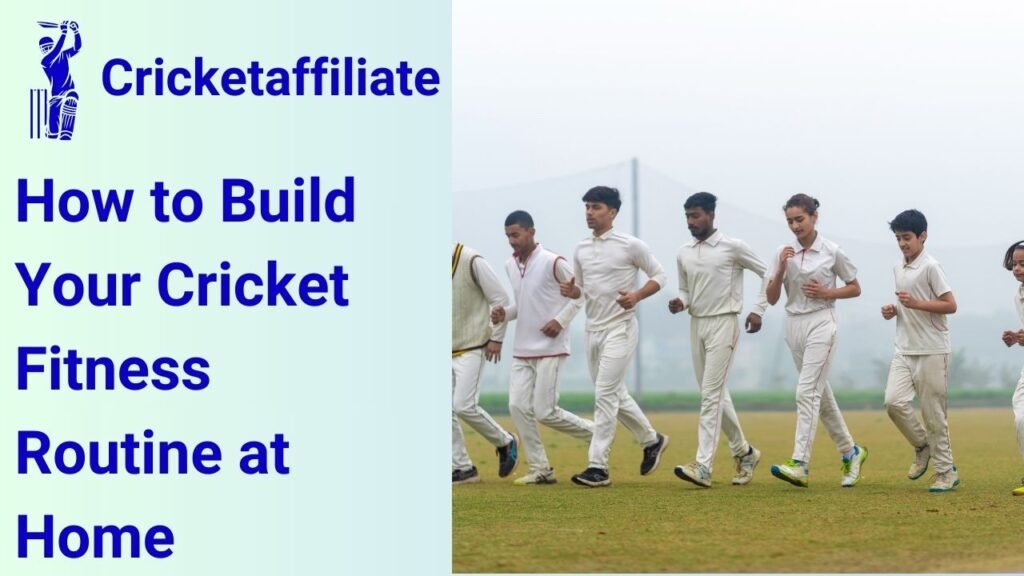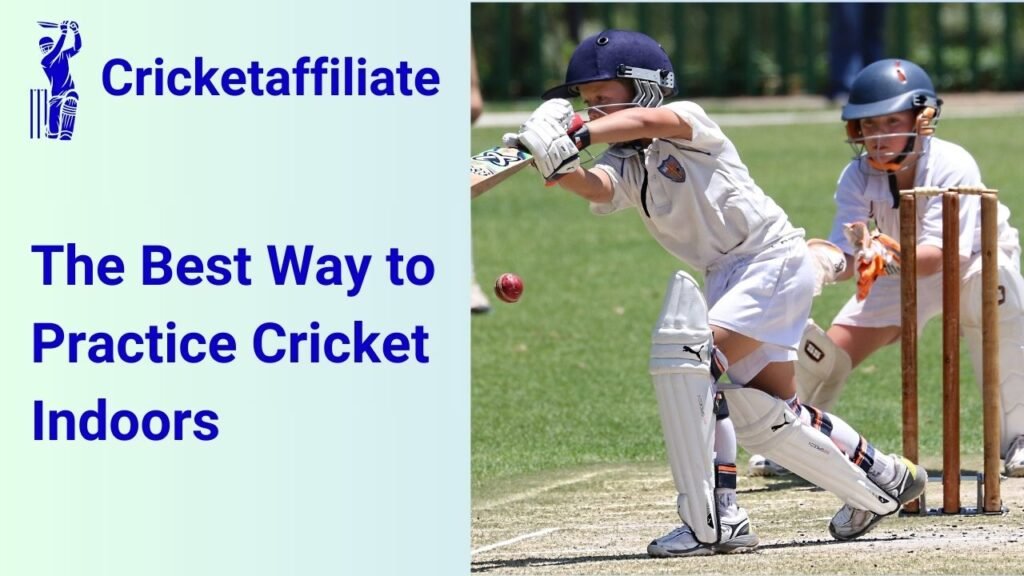Cricket is a physically demanding sport that requires players to excel in strength, endurance, agility, and flexibility. While professional cricketers have access to world-class facilities, fitness training at home can be just as effective when done with the right approach. A home-based cricket fitness routine can help improve your game, prevent injuries, and keep you in top form.
In this article, we’ll guide you step by step on how to build your cricket fitness routine at home, focusing on exercises, strategies, and tips tailored for cricket enthusiasts. Whether you’re an aspiring cricketer or just want to stay fit for the game, this guide will help you develop a personalized workout plan.
Why Fitness Matters in Cricket
Cricket isn’t just about skill; physical fitness plays a critical role in performance. Here’s why fitness is essential for cricketers:
- Endurance: Players need stamina to sustain long matches, especially in Test and One-Day formats.
- Agility: Quick movements are crucial for fielding, running between wickets, and avoiding injuries.
- Strength: Batting, bowling, and throwing require muscular strength.
- Flexibility: Reduces the risk of injury and enhances performance efficiency.
- Mental Toughness: Fitness directly impacts confidence and concentration on the field.
Benefits of a Home-Based Cricket Fitness Routine
Training at home offers several advantages, especially for players who lack access to professional gyms or trainers:
- Convenience: No need to commute to a gym or practice facility.
- Cost-Effective: Utilize minimal equipment and save money on memberships.
- Personalized Plan: Focus on your strengths and weaknesses without distractions.
- Consistency: Regular workouts lead to steady improvement.
Components of an Effective Cricket Fitness Routine
An ideal cricket fitness routine at home combines various elements to build a complete skill set. Here’s what you need to focus on:
| Fitness Component | Purpose in Cricket | Key Exercises |
|---|---|---|
| Cardiovascular Endurance | Sustains energy levels during long matches | Running, skipping, HIIT workouts |
| Strength | Enhances power in shots, bowling, and throws | Bodyweight exercises, resistance bands |
| Agility | Improves quick movement and reflexes | Ladder drills, side shuffles |
| Flexibility | Reduces injury risk and improves mobility | Stretching, yoga |
| Core Stability | Strengthens posture and balance | Planks, Russian twists |
Step-by-Step Guide on How to Build Your Cricket Fitness Routine at Home
1. Warm-Up to Activate Your Body
Every cricket fitness routine should begin with a proper warm-up to prepare your muscles and reduce injury risk. Spend 10-15 minutes doing the following:
- Dynamic stretches: Leg swings, arm circles, and torso twists.
- Light cardio: Jumping jacks, jogging in place, or skipping rope.
- Mobility exercises: Focus on joints like shoulders, hips, and knees.
A good warm-up boosts blood flow and primes your body for intense training.
2. Build Cardiovascular Endurance
Stamina is vital for cricketers, especially during lengthy games. At home, you can improve your endurance with simple yet effective exercises:
- Skipping: Start with 3-5 minutes and gradually increase your time.
- HIIT workouts: Alternate between 30 seconds of high-intensity exercises like burpees and 30 seconds of rest for 15-20 minutes.
- Stair runs: Utilize stairs at home for quick sprints to enhance stamina.
Aim for 3-4 sessions per week to maintain optimal energy levels throughout matches.
3. Strength Training Without Equipment
Cricketers need upper and lower body strength for batting, bowling, and fielding. You don’t need a gym for this; bodyweight exercises can do wonders.
- Push-ups: Improve arm and chest strength for powerful shots.
- Squats: Build lower body strength for running and stability.
- Planks: Strengthen your core, essential for balance and explosive power.
- Resistance band exercises: Use a band to add intensity to bicep curls or lateral raises.
Perform 2-3 sets of 12-15 repetitions for each exercise, focusing on form.
4. Agility Drills for Quick Reflexes
Cricketers must move quickly and efficiently, especially when fielding or running between wickets. Agility drills can sharpen your reflexes and footwork:
- Ladder drills: Mimic ladder movements on the floor using chalk or tape. Practice fast foot movements.
- Side shuffles: Strengthen lateral movement for fielding agility.
- Cone drills: Set up cones and practice zig-zag sprints to simulate match scenarios.
Include 10-15 minutes of agility training in your routine 2-3 times weekly.
5. Improve Flexibility with Stretching
Flexibility enhances movement efficiency and prevents injuries. Incorporate these stretches after every workout:
- Hamstring stretch: Loosen tight leg muscles for better running ability.
- Shoulder stretch: Essential for bowlers and fielders.
- Yoga poses: Try poses like Downward Dog and Cat-Cow to enhance overall flexibility.
Stretching not only improves performance but also aids in faster recovery.
6. Develop Mental Toughness
Physical fitness is incomplete without mental strength. Cricketers face high-pressure situations, and mental resilience is key. To build mental toughness:
- Meditation: Spend 5-10 minutes focusing on deep breathing to enhance focus.
- Visualization: Imagine yourself succeeding in various match scenarios.
- Positive affirmations: Boost confidence with phrases like, “I am prepared and capable.”
7. Cool Down and Recovery
Post-workout recovery is as important as the workout itself. Cooling down helps your muscles relax and prevents stiffness.
- Stretching: Focus on areas worked during the session.
- Foam rolling: If available, use a foam roller to ease muscle tension.
- Hydration: Drink water to replenish lost fluids.
Recovery ensures you’re ready for the next session without burnout.
Sample Weekly Cricket Fitness Plan
Here’s a sample 5-day home fitness routine tailored for cricket:
| Day | Focus | Key Activities |
|---|---|---|
| Monday | Cardiovascular Endurance | Skipping, HIIT workout, light jogging |
| Tuesday | Strength Training | Push-ups, squats, planks, resistance bands |
| Wednesday | Agility and Reflexes | Ladder drills, side shuffles, cone drills |
| Thursday | Flexibility and Core | Yoga, Russian twists, dynamic stretches |
| Friday | Rest and Recovery | Light stretching, meditation, hydration |
Repeat this cycle or adjust it based on your fitness level.
FAQs on How to Build Your Cricket Fitness Routine at Home
1. Do I need equipment for a cricket fitness routine at home?
No, you can rely on bodyweight exercises, household items, or affordable tools like resistance bands and skipping ropes.
2. How often should I train for cricket fitness?
Train 4-5 days a week, incorporating a mix of cardio, strength, agility, and flexibility exercises.
3. Can I improve my bowling speed with home workouts?
Yes, focus on core strength, arm exercises, and flexibility drills to enhance bowling speed and control.
4. Is diet important for cricket fitness?
Absolutely. A balanced diet with adequate protein, carbs, and hydration supports your fitness progress.
5. How long does it take to see results from a home fitness routine?
You’ll notice improvements in 4-6 weeks with consistent effort and proper recovery.
6. What should I do if I feel sore after a workout?
Prioritize stretching, foam rolling, and rest. Soreness is normal and reduces with time.
7. Can teenagers follow this routine?
Yes, this routine is adaptable for all ages. Teens should focus on form and avoid overtraining.
8. What are the best cricket-specific agility drills?
Ladder drills, cone drills, and shuttle runs are highly effective for cricketers.
By following this detailed guide, you can develop a comprehensive cricket fitness routine at home that aligns with your goals and game requirements. Consistency, proper technique, and a positive mindset are key to becoming a fitter, stronger, and more agile cricketer.



